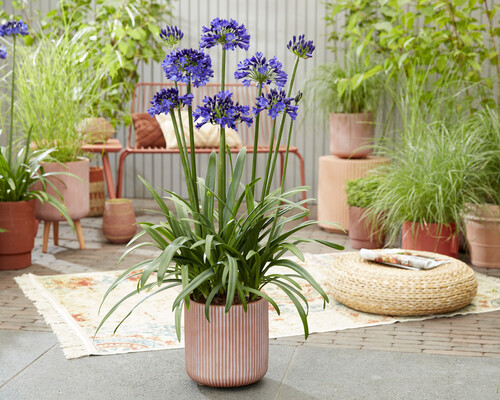Grasping the Art of Agapanthus Treatment: Essential Steps for Healthy Development and Lively Blossoms
In the realm of horticulture, the farming of agapanthus stands as a satisfying endeavor for those who seek to nurture these elegant blooming plants. From selecting the appropriate variety to grasping trimming methods, the journey in the direction of cultivating thriving agapanthus plants is diverse and holds the vital to opening the complete potential of these herb treasures.
:strip_icc()/purple-agapanthus-4637b426-ba6babc24ea34dce9361ec746f6ebc63.jpg)
Choosing the Right Agapanthus Variety

When selecting the best Agapanthus selection for your garden, consider elements such as environment suitability, blossom color, and development habit. In addition, consider the environment in your region to make certain the Agapanthus selection you choose can grow in your certain problems. Recognizing the growth practice of various Agapanthus ranges is critical for appropriate positioning within your yard.
Ideal Planting Problems
Thinking about the optimum ecological demands is vital for effective Agapanthus growing. Agapanthus prospers in well-draining soil with a slightly acidic to neutral pH level. When growing, choose a place that receives full sunshine to partial color. In hotter climates, providing some mid-day color can protect against scorching of the leaves. Agapanthus plants are delicate to chilly temperatures and should be shielded from frost during cold weather.
To ensure healthy growth and vivid blossoms, plant Agapanthus light bulbs at a deepness of regarding 2-4 inches and area them 8-12 inches apart. Mulching around the base of the plants aids keep wetness and reduces weed development.
Watering and Fertilizing Tips
Keeping proper wetness levels and supplying vital nutrients are crucial elements in the care routine for Agapanthus plants. When it pertains to watering Agapanthus, it is critical to strike an equilibrium. These plants choose consistently wet dirt yet are at risk to root rot if overwatered. Throughout the growing period, water deeply once a week, ensuring the dirt is well-draining to stop waterlogging. In hotter environments or during periods of drought, more regular watering may be essential to keep the dirt evenly damp. Nevertheless, minimize watering in the wintertime to avoid waterlogged problems.
Feeding Agapanthus is essential for advertising healthy and balanced growth and prolific blooms. Apply a balanced plant food, such as a 10-10-10 formula, in the early springtime as new development emerges. By adhering to these watering and fertilizing suggestions, you can ensure your Agapanthus plants thrive and generate More Info vibrant, long-lasting blooms.
Trimming Strategies for Agapanthus
Trimming Agapanthus plants at the ideal times and with appropriate strategies is crucial for maintaining their health and advertising optimum development and blooming. The ideal time to trim Agapanthus is in late winter months or very early springtime prior to new development arises.
For flowered stems, wait until the blossoms have actually perished and afterwards trim them back to the base. This not just tidies up the plant's look yet likewise motivates the advancement read this article of new blossom buds. Deadheading spent flowers can likewise reroute the plant's energy into creating more blossoms instead of establishing seeds. However, if you want to gather seeds for breeding, leave some blossoms to fully grown and dry on the plant.
Keep in mind to use tidy, sharp devices to make precise cuts and lower the threat of presenting diseases. Agapanthus. Routine pruning will assist maintain your Agapanthus looking neat and healthy while making sure a bountiful display of lovely blossoms
Taking Care Of Usual Bugs and Diseases
After making sure appropriate pruning methods for Agapanthus, it is necessary to address typical parasites and illness that can affect the wellness and vigor of these plants. One typical bug that impacts Agapanthus is the Agapanthus gall midge.
One more usual concern is fungal fallen leave area, which offers as dark lesions on the fallen leaves. To avoid fungal illness, guarantee excellent air flow around the plants, stay clear of above watering, and eliminate any type of contaminated leaves without delay. In addition, Agapanthus plants can deal with origin rot if they are planted in inadequately draining pipes soil. To stop navigate to this site this, plant Agapanthus in well-draining dirt and avoid overwatering. By being cautious and taking punctual activity against pests and illness, you can assist your Agapanthus plants flourish and produce lively blooms.

Verdict
To conclude, mastering the art of agapanthus care entails picking the appropriate range, providing excellent planting problems, correct watering and feeding, appropriate pruning techniques, and attending to usual parasites and illness. By complying with these necessary steps, you can guarantee healthy and balanced growth and vibrant flowers for your agapanthus plants. Remember to routinely monitor and keep your plants to advertise their general well-being and longevity.
To guarantee healthy and balanced growth and vibrant blooms, plant Agapanthus light bulbs at a deepness of about 2-4 inches and area them 8-12 inches apart. By following these watering and fertilizing suggestions, you can guarantee your Agapanthus plants flourish and generate dynamic, resilient flowers.
One common parasite that affects Agapanthus is the Agapanthus gall midget. Additionally, Agapanthus plants can suffer from origin rot if they are planted in improperly draining pipes soil. By complying with these vital actions, you can make certain healthy growth and dynamic blooms for your agapanthus plants.